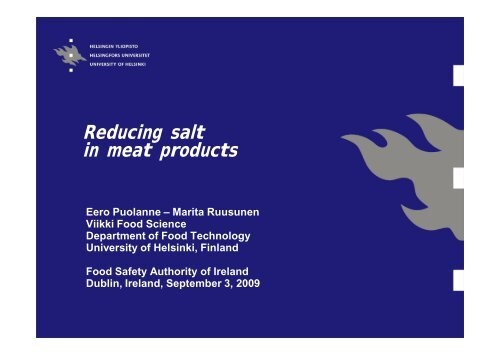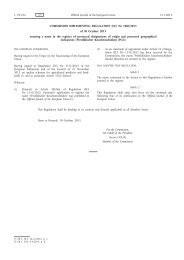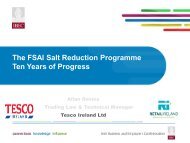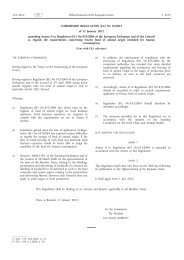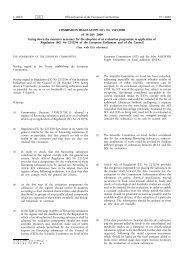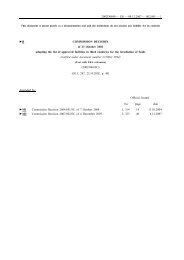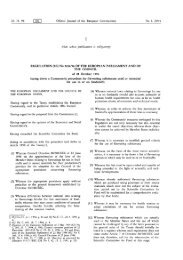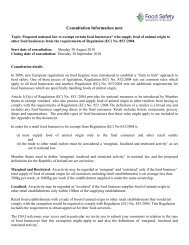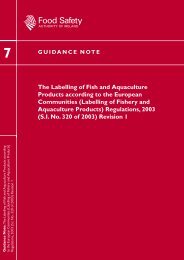Reducing salt in meat products - The Food Safety Authority of Ireland
Reducing salt in meat products - The Food Safety Authority of Ireland
Reducing salt in meat products - The Food Safety Authority of Ireland
Create successful ePaper yourself
Turn your PDF publications into a flip-book with our unique Google optimized e-Paper software.
<strong>Reduc<strong>in</strong>g</strong> <strong>salt</strong><br />
<strong>in</strong> <strong>meat</strong> <strong>products</strong><br />
Eero Puolanne –Marita Ruusunen<br />
Viikki <strong>Food</strong> Science<br />
Department <strong>of</strong> <strong>Food</strong> Technology<br />
University <strong>of</strong> Hels<strong>in</strong>ki, F<strong>in</strong>land<br />
<strong>Food</strong> <strong>Safety</strong> <strong>Authority</strong> <strong>of</strong> <strong>Ireland</strong><br />
Dubl<strong>in</strong>, <strong>Ireland</strong>, September 3, 2009
Salt reduction<br />
PhD<br />
Marita Ruusunen
Conflict <strong>of</strong> <strong>in</strong>terests<br />
nHuman needs/<strong>in</strong>st<strong>in</strong>cs<br />
n sweet: energy<br />
n sour: homeostasis; acidbase balance/spoilage<br />
n <strong>salt</strong>y: m<strong>in</strong>eral balance<br />
n bitter: toxic<br />
n umami: prote<strong>in</strong><br />
npeople want to eat sweet, <strong>salt</strong>y, and umamitast<strong>in</strong>g<br />
foods, repeatedly and as much as<br />
possible<br />
n"fat has no taste receptor", but <strong>in</strong>ternal signall<strong>in</strong>g<br />
n textural and <strong>in</strong>direct effects<br />
n pool <strong>of</strong> flavour precursors<br />
n CD36 fat transporter (Dransfield, ICoMST 2008)<br />
nif eat<strong>in</strong>g is not limited <strong>in</strong> a long term fatness,<br />
unbalanced nutrition heath problems
Conflict <strong>of</strong> <strong>in</strong>terests<br />
nHuman needs are utilized by the <strong>in</strong>dustry<br />
n fat, <strong>salt</strong>, sugar is added alone or <strong>in</strong> comb<strong>in</strong>ation<br />
n consumers do <strong>in</strong>st<strong>in</strong>ctly want that<br />
nHealt problems/responsibility??<br />
n science: nutrition<br />
n health: authorities/<strong>in</strong>dustry??/consumers??<br />
n <strong>in</strong>formation and consciousness<br />
what do you want that your children eat?<br />
nWhen to start, when there is a proper time?<br />
n those who do not, get their <strong>products</strong> well sold?<br />
nA leagal issue, and nutritional guidance as well<br />
required
Coronary heart<br />
disease mortality,<br />
men 3564 y.<br />
Cases/100 000<br />
(WHO)<br />
1970<br />
about 70 000+<br />
early deaths less<br />
Of that reduction<br />
<strong>of</strong> blood pressure<br />
15 00020 000<br />
(In<strong>of</strong>ficial<br />
calculations/Epu)
Mortality (%)<br />
Smok<strong>in</strong>g<br />
Blood pressure<br />
Cholestrol<br />
Predicted<br />
Real<br />
<strong>The</strong> real and<br />
predicted<br />
CHD mortality<br />
by 35 64 men<br />
<strong>in</strong> F<strong>in</strong>land
Sources <strong>of</strong> sodium (%) <strong>in</strong> the diet<br />
<strong>Food</strong> sector <strong>Ireland</strong> 1 UK 2 USA 3 F<strong>in</strong>land 4<br />
Cereals and<br />
cereal <strong>products</strong> 35 38 27 35<br />
Meat & <strong>meat</strong><br />
<strong>products</strong> 21 21 21 30 5<br />
Soups & sauces 7 13 8<br />
Processed<br />
vegetables 4 9 7 9<br />
Milk and cream 9 5 7 10<br />
Fish dishes 10<br />
1 FSAI (2005); 2 SACN (2003); 3 Engström et al. (1997); 4 F<strong>in</strong>diet 2002; 5 <strong>in</strong>cluded <strong>meat</strong> dishes
From <strong>The</strong>o Verkleij, TNO, NL<br />
9<br />
18<br />
16<br />
14<br />
12<br />
10<br />
8<br />
6<br />
4<br />
2<br />
0<br />
Salt consumption Europe<br />
2008 Collated <strong>in</strong>formation on <strong>salt</strong> reduction <strong>in</strong> the EU<br />
Denmark women<br />
Netherlands women<br />
F<strong>in</strong>land women<br />
F<strong>in</strong>land men<br />
France<br />
UK 2006<br />
Iceland<br />
Netherlands men<br />
<strong>salt</strong> <strong>in</strong>take <strong>in</strong> gram/day<br />
Denmark men<br />
<strong>Ireland</strong><br />
Italy<br />
Norway<br />
Belgium<br />
Lithuania<br />
Sweden<br />
Czech Republic<br />
Switzerland<br />
Bulgaria<br />
Portugal 2006<br />
Spa<strong>in</strong><br />
Slovenia<br />
Hungary women<br />
Hungary men<br />
NPA HLG/2008 28 april<br />
Introduction –Improv<strong>in</strong>g health –Effect other cations –Substantial reduction sodium Conclusion
From <strong>The</strong>o Verkleij, TNO, NL<br />
10<br />
selected risk factors<br />
1<br />
Deaths attributed to lead<strong>in</strong>g risk factors<br />
Deaths <strong>in</strong> Europe 2000<br />
0 500 1000 1500 2000 2500 3000<br />
number <strong>of</strong> deaths [000]<br />
urban air pollution<br />
alcohol use<br />
physical <strong>in</strong>activity<br />
low fruit and vegetable <strong>in</strong>take<br />
high body mass <strong>in</strong>dex<br />
use tabacco<br />
high cholesterol<br />
high blood pressure<br />
World Health Report 2002<br />
Introduction –Improv<strong>in</strong>g health –Effect other cations –Substantial reduction sodium Conclusion
g/d<br />
National average 1980<br />
Men 2002 Men 2007 Women 2002 Women 2007<br />
Other foods<br />
Vegetable foods<br />
Salt <strong>in</strong> F<strong>in</strong>nish diet <strong>in</strong> 2002 and 2007 (<strong>Food</strong> Balance Studies 2007)<br />
Fatfs<br />
Dairy <strong>products</strong> and<br />
cheeses<br />
Fish<br />
Bread and cereal<br />
<strong>products</strong><br />
Meat dishes and <strong>products</strong>
Meat <strong>products</strong> as source <strong>of</strong> sodium<br />
Pearson and Wolzak, 1982<br />
Added<br />
amount g/kg<br />
Na content<br />
%<br />
Na<br />
mg/100 g<br />
Natural Na 515<br />
NaCl 1830 39.3 7071178<br />
Na tripolyphosphate<br />
2.55.0 31.2 78156<br />
Na ascorbate<br />
or erytorbate<br />
0.6 11.6 7<br />
NaNO 2 0.12 33.2 4<br />
NaNO 3 0.3 27.1 8<br />
Monosodium<br />
glutamate<br />
12 13.6 1427<br />
Na lactate 12 24 288
Waterb<strong>in</strong>d<strong>in</strong>g<br />
Firmness and consistency<br />
“Quality”<br />
<strong>The</strong> role <strong>of</strong> water content <strong>in</strong> cooked sausage
+<br />
+<br />
+<br />
+<br />
+<br />
+<br />
<br />
<br />
<br />
<br />
<br />
<br />
<br />
<br />
<br />
<br />
+<br />
+<br />
+<br />
+<br />
+<br />
+<br />
Basis for osmotic pressure<br />
+<br />
+<br />
+<br />
+<br />
+<br />
+<br />
My<strong>of</strong>ilamentit Poikittaissidokset<br />
My<strong>of</strong>ilaments Crossbridges<br />
<br />
<br />
<br />
<br />
<br />
<br />
<br />
<br />
<br />
<br />
+<br />
+<br />
+<br />
+<br />
+<br />
+<br />
pH , <strong>salt</strong>s , phosphates WBC<br />
+<br />
+<br />
+<br />
+<br />
+<br />
+<br />
+<br />
+<br />
+<br />
+<br />
+<br />
<br />
<br />
<br />
<br />
<br />
<br />
<br />
<br />
<br />
<br />
pH , suola , fosfaatti > VSK nousee<br />
+<br />
+<br />
+<br />
+<br />
+<br />
+<br />
+<br />
+<br />
+<br />
+<br />
+<br />
+<br />
+<br />
+<br />
+<br />
+<br />
+<br />
+<br />
+<br />
+<br />
+<br />
+<br />
<br />
<br />
<br />
<br />
<br />
<br />
<br />
<br />
<br />
<br />
+<br />
+<br />
+<br />
+<br />
+<br />
+<br />
+<br />
+<br />
+<br />
+<br />
+
Basis for osmotic pressure<br />
+ + + +<br />
+ + + + +<br />
+ + + +<br />
+ + + + + + + + + + + <br />
+ + + + + + + + + + + + +<br />
+ + + + + + + + + ++ + + + +<br />
+ + + + +++++++++++ + + + <br />
Neg.<br />
+ + + +++++++++ + + + + + <br />
+ + + + + + + + + + + + + +<br />
+ + + + + ++ + + + + + + +<br />
+ + ++ + + + + + + + + +<br />
+ + + + +<br />
+ + + + +<br />
Prote<strong>in</strong><br />
filament<br />
Ø 16 nm<br />
Positive ions form a ”cloud” around the negatively charged<br />
my<strong>of</strong>ilament<br />
Chloride is important for WBC and structure<br />
Sodium is important for taste
A) Salt content and waterb<strong>in</strong>d<strong>in</strong>g<br />
o = no added water, = 60 % added water. (Hamm 1975).<br />
B) Swell<strong>in</strong>g <strong>of</strong> a my<strong>of</strong>ibril (Offer 1988).
Mechanism <strong>of</strong> swell<strong>in</strong>g<br />
(a) before <strong>salt</strong><strong>in</strong>g<br />
(b) <strong>salt</strong>ed my<strong>of</strong>ilament (myos<strong>in</strong>)<br />
(c) high <strong>salt</strong> and added water. (Offer & Knight 1988).
Water<br />
b<strong>in</strong>d<strong>in</strong>g<br />
capacity<br />
(= gell<strong>in</strong>g<br />
strength)<br />
1.5 % is critical<br />
Fat moves the curve<br />
"to the northwest"<br />
low fat, low <strong>salt</strong><br />
challenc<strong>in</strong>g!<br />
With<br />
phosphate<br />
Without<br />
phosphate<br />
0.0 0.5 1.0 1.5 2.0 2.5<br />
% NaCl
0,0<br />
0,3<br />
0.6<br />
0,9<br />
1,2<br />
1,5<br />
1,8<br />
2,4<br />
3,0<br />
Salt only Salt + phosphates<br />
Offer and Knigth 1988<br />
0,0<br />
0,35<br />
0.7<br />
1,05<br />
1,4<br />
1,75<br />
2,1<br />
2,8<br />
3,5
Salt is necessary for sausage stucture<br />
With phosphates
Salt content %<br />
<strong>The</strong> <strong>salt</strong> content <strong>in</strong> cooked sausages<br />
<strong>in</strong> F<strong>in</strong>land 197395<br />
Puolanne<br />
<strong>The</strong> First F<strong>in</strong>nish<br />
Concensus Meet<strong>in</strong>g<br />
Hels<strong>in</strong>ki 1997<br />
Low fat, high <strong>meat</strong><br />
R<strong>in</strong>g sausage<br />
Average<br />
Frankfurter<br />
Current average<br />
1.61.7 %!
pH and waterb<strong>in</strong>d<strong>in</strong>g capacity<br />
Waterb<strong>in</strong>d<strong>in</strong>g<br />
capacity<br />
Salt<br />
3 4 5 6 7 pH<br />
No <strong>salt</strong><br />
<strong>The</strong> effect <strong>of</strong> pH on the<br />
waterb<strong>in</strong>d<strong>in</strong>g capacity<br />
<strong>of</strong> <strong>meat</strong>. (Hamm1972)
+ 12 %<br />
More (bad) pH sensitive Less<br />
Less (bad)<br />
<strong>salt</strong><br />
sensitive<br />
More<br />
Puolanne et al. 2001
In practice ca 3% NaCl<br />
Figure 3. <strong>The</strong> effect <strong>of</strong> ionic strength and pH on waterb<strong>in</strong>d<strong>in</strong>g <strong>in</strong> sausage.<br />
Black l<strong>in</strong>e <strong>in</strong>dicates the estimated course <strong>of</strong> pHionic strength <strong>in</strong> fermented<br />
sausage dur<strong>in</strong>g ripen<strong>in</strong>g (Puolanne ja Peltonen, <strong>in</strong> preparation)
Examples <strong>of</strong> <strong>salt</strong> substitues: each row<br />
has the same sodium content<br />
NaCl, % PANSalt®, % Biosal, %<br />
1.0 1.75 1.52<br />
1.2 2.11 1.82<br />
1.5 2.63 2.27<br />
1.8 3.16 2.73<br />
2.1 3.68 3.18<br />
PANSalt®: 57% NaCl, 28% KCl, 12% MgCl 2, 2% Lys<strong>in</strong>eHCL<br />
Biolsal: 66 % NaCl, 31 % KCl, 3 % prote<strong>in</strong> hydrolysate etc<br />
Sodium reduction is not the same as <strong>salt</strong> reduction!
Technological aspects<br />
§ Sausages, hams<br />
§ Fermented <strong>products</strong><br />
§ Prepared foods
Cooked sausage<br />
§ without phosphate to 1.1 % NaCl (technologically)<br />
§ with phosphate 1.0 % (basic Kphosphate)<br />
§ problems <strong>of</strong> purge and/or gra<strong>in</strong>y structure may arise<br />
§ <strong>in</strong> low <strong>salt</strong> <strong>products</strong> the phosphate is more important<br />
§ added water and/or fat maybe should be reduced<br />
(price!)<br />
§ with <strong>salt</strong> mixtures, easy to achieve<br />
§ soy prote<strong>in</strong>, carrageenan, potato flour<br />
§ microbial safety is not relevantly changed (i.e. is<br />
perishable anyway!)<br />
§ at
(Sausage) formulation<br />
Prepare concentrated <strong>in</strong>dustrial foods<br />
– use extenders <strong>in</strong> moderation<br />
– usually <strong>in</strong>crese the amount <strong>of</strong> <strong>salt</strong>, sugar and fat<br />
– aga<strong>in</strong>, conflict <strong>of</strong> <strong>in</strong>terest<br />
extend<strong>in</strong>g usually lowers the price/ kg<br />
efficiency will be reduced<br />
– nutritionally, pricewise and environmentally<br />
– the consumer actually looses (and the producer w<strong>in</strong>s?)<br />
sensory effects?<br />
easy to eat?<br />
2 g <strong>salt</strong><br />
Extender effect<br />
4 g <strong>salt</strong> + others<br />
problem <strong>of</strong> changed food systems and eat<strong>in</strong>g patterns<br />
preferably dense foods even with more sodium than large<br />
quantities <strong>of</strong> foods with low sodium content<br />
– "Enhanced" <strong>products</strong>!!!<br />
br<strong>in</strong>e <strong>in</strong>jection to traditional <strong>meat</strong> foods!
Cooked ham<br />
§ without phosphate to 1.4 % NaCl<br />
§ with phosphate 1.3 % (basic Kphosphate)<br />
§ problems <strong>of</strong> purge and/or gra<strong>in</strong>y structure may<br />
arise<br />
§ added water maybe should be reduced (price!)<br />
§ with <strong>salt</strong> mixtures, easy to achieve<br />
§ soy prote<strong>in</strong>, carrageenan<br />
§ microbial safety is not relevantly changed (i.e. is<br />
perishable anyway!)<br />
§ at 1.4 –1.6 % NaCl, typical flavour is lost!!!<br />
§ conclusion: total sodium max. 600 mg Na/100g<br />
can be reached!
Cooked hamburger<br />
§ consumers prefer 1.11.3 % NaCl<br />
§ when lower<strong>in</strong>g, problems <strong>of</strong> purge and/or<br />
gra<strong>in</strong>y structure may arise<br />
§ added water maybe should be reduced<br />
(price!)<br />
§ with <strong>salt</strong> mixtures, easy to achieve<br />
§ soy prote<strong>in</strong>, carrageenan, potato flakes<br />
§ microbial safety is not relevantly changed<br />
(i.e. is perishable anyway!)<br />
§ lower<strong>in</strong>g to 0.7 % possible (300 mg Na/100<br />
g)
NaCl content <strong>of</strong> commercial <strong>meat</strong><br />
balls <strong>in</strong> F<strong>in</strong>land (Ruusunen, unpublished)<br />
NaCl%<br />
2,5<br />
2<br />
1,5<br />
1<br />
0,5<br />
0<br />
1 2 3 4 5 6 7 8 9 10 11 12 13 14<br />
Meat ball<br />
Through Cl<br />
NaCl% (Clmittaus)<br />
Through Na<br />
NaCl% (Namittaus)
Fermented sausages<br />
n So many types and technologies!<br />
n When real fermentation is used, 2.2% NaCl seems to<br />
be the lowest level<br />
n Quality?<br />
n Microbial safety?<br />
n In ready product the level is about 4%<br />
n Salt mixtures have been studied, and used as well<br />
n IRTA: 50% NaCL can be replaced with KCl<br />
n <strong>The</strong> relevance <strong>of</strong> should be evaluated on the basis <strong>of</strong><br />
consumption data
Microbiology and safety
Our results on keepability<br />
nIn cooked sausage<br />
n 1.1% NaCl/ 1.7% NaCl / 1.9% PanSalt (57% NaCl+28% KCl<br />
+12%MgCl 2+2%Lys<strong>in</strong>eHCL)<br />
no relevant differences were seen<br />
lower level showed, however, somewhat lower keepability<br />
at longer keep<strong>in</strong>g times<br />
pathogenic bacteria were not tested<br />
nIn cooked ham<br />
n 1.4 and 1.7% NaCl, 2.1% Biosal (66 % NaCl, 31% KCl, 3% prote<strong>in</strong><br />
hydrolysate etc.)<br />
n no systematic differences<br />
n <strong>in</strong> 1.4% NaCl after longer keep<strong>in</strong>g time: <strong>of</strong>fflavours more<br />
than <strong>in</strong> others<br />
n<strong>The</strong> ma<strong>in</strong> concern is the afterprocesscontam<strong>in</strong>ation.
Perceived <strong>salt</strong><strong>in</strong>ess<br />
Without courtesy <strong>of</strong> Eric Dransfield or
Perceived <strong>salt</strong><strong>in</strong>ess<br />
nPerceived <strong>salt</strong><strong>in</strong>ess: <strong>salt</strong> ions must be<br />
simultaneously <strong>in</strong> <strong>salt</strong> taste cells<br />
n only the <strong>salt</strong> <strong>in</strong> saliva tastes <strong>salt</strong>y<br />
n saliva <strong>salt</strong> level is a reference when less <strong>salt</strong> is used <strong>in</strong><br />
diet, less <strong>salt</strong> will be perceived <strong>salt</strong>y<br />
n detection treshold, recognition treshold, just noticable<br />
difference, term<strong>in</strong>al treshold, all vary from product to<br />
product<br />
n <strong>salt</strong> <strong>in</strong>fluences other aspects than taste only, and they <strong>in</strong><br />
turn affect the taste and flavour (e.g. consistency, water<br />
b<strong>in</strong>d<strong>in</strong>g, the b<strong>in</strong>d<strong>in</strong>g <strong>of</strong> aroma compounds to the matrix)<br />
nMeat prote<strong>in</strong>s b<strong>in</strong>d <strong>salt</strong> less perceived <strong>salt</strong><strong>in</strong>ess
Loosely bound sodium and chloride?<br />
+ + + +<br />
+ + + + +<br />
+ + + +<br />
+ + + + + + + + + + + <br />
+ + + + + + + + + + + + +<br />
+ + + + + + + + + ++ + + + +<br />
+ + + + + ++++++ + + + <br />
Neg.<br />
+ + + +++++++++ + + + + + <br />
+ + + + + + + + + + + + + +<br />
+ + + + + ++ + + + + + + +<br />
+ + ++ + + + + + + + + +<br />
+ + + + +<br />
+ + + + +<br />
Prote<strong>in</strong><br />
filament<br />
Ø 16 nm<br />
Positive ions form a ”cloud” around the negatively charged<br />
my<strong>of</strong>ilament<br />
Chloride is important for WBC and structure<br />
Sodium is important for taste
7<br />
6<br />
5<br />
4<br />
3<br />
2<br />
1<br />
Perveived <strong>salt</strong><strong>in</strong>ess <strong>of</strong> <strong>meat</strong> patties<br />
conta<strong>in</strong><strong>in</strong>g different amount <strong>of</strong> fat and<br />
lean <strong>meat</strong><br />
10% 1 20%<br />
50% 2 60%<br />
Fat content<br />
Meat content<br />
This is<br />
a significant<br />
message!
THE EFFECT OF FAT CONTENT ON THE PERCEIVED SALTINESS OF ‘BOLOGNA<br />
TYPE’ COOKED SAUSAGES<br />
Fat content varied by replac<strong>in</strong>g lean pork with pork fat<br />
Salt<strong>in</strong>ess<br />
9<br />
8<br />
7<br />
6<br />
5<br />
4<br />
3<br />
2<br />
1<br />
0<br />
a<br />
a<br />
ab<br />
ab<br />
a<br />
ab ab<br />
8 12 16 20 24 28<br />
Fat content (%)<br />
abc<br />
1.2% NaCl<br />
2.0% Na Cl<br />
c bc<br />
b b<br />
This is<br />
a significant<br />
message!
THE EFFECT OF FAT CONTENT ON THE PERCEIVED SALTINESS OF<br />
BOLOGNATYPE COOKED SAUSAGES<br />
Fat content varied by replac<strong>in</strong>g water with pork fat<br />
Salt<strong>in</strong>ess<br />
9<br />
8<br />
7<br />
6<br />
5<br />
4<br />
3<br />
2<br />
1<br />
0<br />
8 12 16 20 24 28<br />
Fat content (%)<br />
1.2% NaCl<br />
2.0% NaCl<br />
This is<br />
a significant<br />
message!
Tim<strong>in</strong>g <strong>of</strong> <strong>salt</strong><strong>in</strong>g Taste buds<br />
?<br />
Water and prote<strong>in</strong>s<br />
Pre<strong>salt</strong>ed Onpan <strong>salt</strong>ed Onplate <strong>salt</strong>ed<br />
With the onplate <strong>salt</strong><strong>in</strong>g a <strong>salt</strong> reduction <strong>of</strong> 3040 % for beef and 5060 %<br />
for pork can be achieved. Similar reduction will be <strong>in</strong> prepared foods.
Conclud<strong>in</strong>g, perceived <strong>salt</strong><strong>in</strong>ess<br />
§ Meat prote<strong>in</strong>s b<strong>in</strong>d <strong>salt</strong> less perceived <strong>salt</strong><strong>in</strong>ess<br />
§ When <strong>salt</strong> added on plate, the <strong>salt</strong> does not penetrate <strong>in</strong>to<br />
the <strong>meat</strong> food will be perceived more <strong>salt</strong>y<br />
§ beef steak ca. 40% reduction<br />
§ pork chops ca 60 % reduction<br />
§ Do not use <strong>salt</strong> at all <strong>in</strong>to the food dur<strong>in</strong>g the preparation!<br />
check where it is possible (<strong>in</strong> most readytoeat foods)<br />
do not listen to your mother or a cook!<br />
one gram, on plate, is enough for a whole meal!!!<br />
<strong>in</strong>sert a onegram bag <strong>of</strong> <strong>salt</strong> with the food!, i.e. let the<br />
consumer decide, how much <strong>salt</strong> will be enough!!!<br />
<strong>in</strong> most cases the keepability is not a problem
Reduction<br />
§ Most simple: cut first the highest contents<br />
§ General reduction slowlier<br />
§ Regognize the development!<br />
§ When lower levels turn more usual, higher<br />
values may <strong>of</strong>fer a commercial advantage!
Policy?
Policy?
F<strong>in</strong>nish "reduced <strong>salt</strong>" claim<br />
(cooked and raw)
F<strong>in</strong>nish "reduced <strong>salt</strong>" claim<br />
Salt?<br />
Normal? where?<br />
Formulation/cooked?<br />
–a marg<strong>in</strong>al <strong>of</strong> about 0.2 % required<br />
–e.g. frankfurter 1.4 % NaCl when prepared (cook<strong>in</strong>g loss,<br />
cool<strong>in</strong>g <strong>in</strong> br<strong>in</strong>e <strong>in</strong> 6 ºC <strong>in</strong>crease the content)<br />
Low fat/low <strong>salt</strong>/low sodium?
Conclud<strong>in</strong>g remarks<br />
§ Technologically a significant reduction <strong>in</strong> <strong>salt</strong><br />
contents can be achieved, by us<strong>in</strong>g e.g.<br />
§ phosphates<br />
§ (high pH <strong>meat</strong>)<br />
§ <strong>salt</strong> substitutes<br />
§ other <strong>in</strong>gredients: extenders and thicken<strong>in</strong>g agents like<br />
soya, modified starches, case<strong>in</strong>ates, etc.<br />
(amount/content relation must be checked!!!)<br />
§ transglutam<strong>in</strong>ases<br />
§ hydrostatic high pressure<br />
§ Technology or shelf life are not particular problems<br />
§ But: <strong>The</strong> taste is the limit<strong>in</strong>g factor
Conclud<strong>in</strong>g remarks (cont.)<br />
§ Sodium reduction depends on the composition <strong>of</strong> the <strong>meat</strong> product<br />
§ Meat <strong>products</strong> with higher percentage <strong>of</strong> lean <strong>meat</strong> need more <strong>salt</strong> to achieve the<br />
same level <strong>of</strong> perceived <strong>salt</strong><strong>in</strong>ess than those with lower percentage<br />
§ Meat <strong>products</strong> with lower fat content need more <strong>salt</strong> to achieve the same level <strong>of</strong><br />
perceived <strong>salt</strong><strong>in</strong>ess than those with higher<br />
§ <strong>The</strong> acceptance level must be tested<br />
§ product by product,<br />
§ by consumer segments<br />
§ as well as by nationalities


